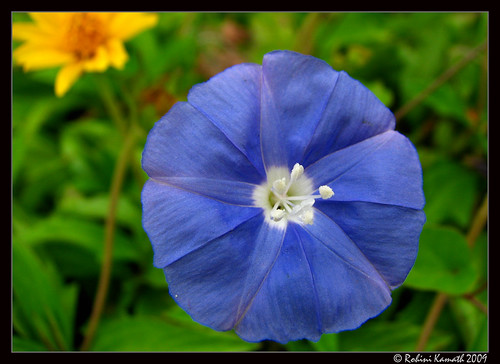
I love the star shape that forms
I first saw this adorable little creeper at a nursery on the way back from Manchinbele. On impulse I bought it and set it on our fence. As it grew, we liked it so much we got it a friend and set it on the other side of the terrace. ( Nothing like a little competition to speed things up, I thought ).
Sure enough, the two actively compete in terms of flowers and height. Among one of the happiest plants I have seen, it is common in most software parks and let loose on fences. It is not invasive. Its a twining vine with stems to 6 feet or more in length. It is a rapid grower, mine has reached nearly 5 ft (in 3-4 months).
Its a lovely bright green plant with small leaves in the shape of elongated hearts. The blue flowers stand up to face the sun, incase you are letting it loose on the ground. The Flowers come in clusters of buds and take turns flowering. The flower is the size of a 1 rupee coin. After flowering, the flowers fold up like an umbrella and drop off.

A closed flower, note the leaves
Details:
Common name: Skyblue Clustervine, Pentantha
Botanical name: Jacquemontia pentanthos
Family: Convolvulaceae (Morning glory family)
It is a perennial( blooms all year round) and is an introduced species in India.
Can I eat it?
No idea. But birds sure like it. Our friendly neighborhood sunbirds cant get enough of it. They visit twice a day ( morning 9:30am and afternoon 1:30pm )
Also seen eating the flowers are younger members of our Jungle Crow family, a group of 3 flower peckers and a whole bunch of jungle mynas ( we counted 5 ).

Purple Rumped Sunbird Female, they visit daily
Care and Growing:
It needs almost no care at all, though if you'd like more flowers, you may want to water it once in a while. :) It likes the sun, as much as you can provide. Its pretty little blue flowers open in the morning and close before sunset.
Experts recommend that we avoid watering the vine excessively, always leaving the soil dry for a few days between one watering and the other. This pretty much describes how I operate; watering once in a while, when guilt strikes.
It can be grown in containers or pots, I have placed it in ground on our terrace. Since it doesnt spread laterally, it can be easily grown in suspended baskets or left to climb over a balcony.
Till date, I haven't seen it being attacked by any bugs, so it would be safe to assume its a hardy little fellow. Insects seem to like it, I have seen butterflies, bees and a praying mantis on it.

Purple Rumped Sunbird Male, (see the purple flash on its tail, from which it gets its name)
Where did it come from?
Originating in Tropical America, it is Native to the Florida Keys. I was alarmed to see it marked as endangered in Florida.
This plant has been said to be natively growing in the following regions:
Punta Gorda, Florida
Coushatta, Louisiana
For the botanist:
herbaceous vine, slender; lvs ovate, acute at tips, bases subcordate, 2-5+ cm long; flrs axillary, densely cymose on peduncles longer than the lvs, usually only 1 to 2 open; corollas blue (may be white), 10-20 mm long and wide when open; capsule enclosed by sepals; seeds glabrous, bumpy; hammocks; Collier, Dade and Monroe [ incl. Keys] cos.

This one has been photoshopped a bit, to darken the white background
Making more Skyblue Vines
It can be propagated from cuttings ( softwood or semi-hardwood cuttings ). I haven't tried this myself. Its relatively cheap ( 10Rs ), so I just buy another one. I haven't the heart to watch a cutting die.
Where to buy
Easily available in most nurseries. Ive seen it in Jeevan Bhima Nagar and in those near Mancinbele.
Sources:
Flowers Of India
Plant Files
Florida Endangered Plants





